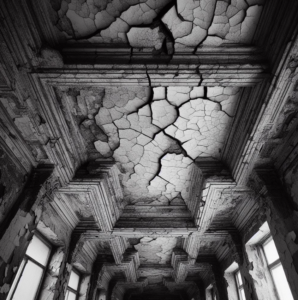 Spotting cracks in walls and ceilings can trigger concern, hinting at potential underlying structural issues demanding prompt attention. These fractures manifest in diverse sizes and shapes, spanning from barely noticeable hairline cracks to more conspicuous and extensive rifts. Understanding these variations is pivotal in diagnosing the primary source of the problem.
Spotting cracks in walls and ceilings can trigger concern, hinting at potential underlying structural issues demanding prompt attention. These fractures manifest in diverse sizes and shapes, spanning from barely noticeable hairline cracks to more conspicuous and extensive rifts. Understanding these variations is pivotal in diagnosing the primary source of the problem.
Hairline cracks, typically narrower than 1/16th of an inch, are commonly perceived as less severe and can arise due to minor settling or fluctuations in environmental conditions like temperature and humidity. Conversely, wider cracks, especially those surpassing 1/8th of an inch, warrant heightened scrutiny. Vertical cracks might serve as indicators of underlying foundation settlement, while horizontal ones might signify more substantial structural concerns that merit closer examination.
Ceiling cracks, with origins tied to structural shifts, moisture, or inadequate construction, present their unique set of challenges. These cracks often materialize near corners or edges, acting as indicators of stress points within the structure. Observing the pattern, size, and location of these cracks is imperative, serving as crucial pointers to decipher the root cause behind their emergence.
Regular and diligent inspections play a crucial role in early detection and mitigation. Employing a flashlight for a meticulous examination of these cracks aids in assessing their width, depth, and any changes over time. Maintaining a vigilant eye for alterations in size or patterns becomes imperative in gauging the gravity of potential structural damage lurking within.
Routinely observing and documenting these fissures assists professionals in providing accurate assessments and subsequent recommendations for necessary repairs or structural reinforcements. Timely action based on astute observations becomes instrumental in preventing these minor fissures from escalating into major structural hazards, ensuring the longevity and safety of your property.
Understanding Causes of Structural Damage
Understanding the underlying reasons behind the appearance of cracks in walls and ceilings is pivotal to devising effective solutions for structural issues. Several factors contribute to the emergence of these problematic cracks:
Foundation Challenges: Structural damage often stems from foundation settlement, triggered by factors like soil movement, inadequate soil compaction, or deficient drainage systems. These issues can exert pressure on the building’s structure, leading to the formation of cracks in walls and ceilings.
Excessive Moisture Intrusion: Water infiltration caused by plumbing leaks, roof issues, or insufficient waterproofing poses a significant threat to the structural integrity of a building. Excessive moisture weakens materials and can result in cracks and deterioration over time.
Construction Deficiencies: Flaws in construction or design, such as the use of subpar building materials, inadequate reinforcement, or improper construction practices, contribute to structural vulnerabilities. These deficiencies may pave the way for cracks and compromise the stability of walls and ceilings.
Natural Forces: Environmental factors like seismic activities, earthquakes, or settling due to the aging of the structure can exert stress on the building, leading to the formation of cracks as the materials shift and settle.
Identifying and addressing the root cause of these structural issues is paramount to halt further damage and ensure the enduring stability of the building. Implementing appropriate measures to mitigate these causes can prevent the aggravation of cracks, preserving the structural integrity and safety of the property.
Professional assessment and intervention play a significant role in diagnosing the specific cause behind structural damage. Expert analysis assists in identifying the contributing factors and prescribing targeted solutions tailored to rectify the underlying issues. Timely and informed actions taken to address these causes prove instrumental in safeguarding the structure against potential deterioration and ensuring its long-term durability.
By comprehending the diverse factors that contribute to structural damage, property owners can proactively take steps to address these issues, preserving the integrity of their buildings and ensuring a secure living or working environment for years to come.
Solutions and Remedies
Addressing cracked walls and ceilings necessitates a methodical approach that aligns with the severity and root cause of the damage. To tackle these issues effectively, a range of solutions and remedies are available:
Hairline Cracks: For minor cracks, employing an appropriate sealant or patching compound proves effective. Prior to application, ensure the area is thoroughly clean and dry to facilitate optimal adhesion of the sealant.
Wider Cracks: Cracks that are more pronounced may require a more comprehensive approach. Utilizing epoxy or polyurethane foam for injection into these wider cracks serves to stabilize the affected areas and effectively fill the voids, restoring structural integrity.
Severe Structural Damage: In cases of extensive damage that compromise the structural integrity, seeking professional assistance becomes imperative. Consulting with experienced structural engineers or contractors is crucial to conduct a thorough assessment and implement targeted solutions addressing the underlying issues.
Preventing future damage involves addressing moisture sources that contribute to structural issues. Initiatives such as enhancing drainage systems, ensuring adequate ventilation, and maintaining consistent humidity levels play a significant role in safeguarding against potential damage recurrence.
Implementing these remedial measures establishes a foundation for the long-term health and stability of the structure. Timely and appropriate interventions based on the severity of the damage prevent minor fissures from escalating into more substantial structural hazards, ensuring the safety and durability of the building.
By taking a proactive stance towards remediation and implementing tailored solutions, property owners can mitigate the risks associated with structural damage, fortifying their properties against future challenges. These initiatives contribute significantly to preserving the value and integrity of the structure, fostering a secure and conducive environment for its occupants.